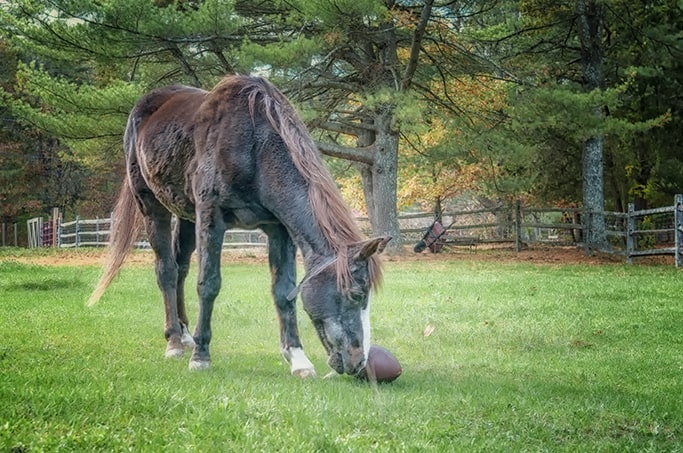
Photo: Sheepish Grin Photography
Enrichment is often thought of as an “extra”, or optional provision for residents. Sanctuary workers are understandably focused on providing the food, water, and housing necessary for residents to live. However, we are hoping that by incorporating enrichment as an aspect of general care, the lives of residents will be enriched. This is of particular importance for residents residing in smaller, more confined, or barren living spaces. In cases like these, enrichment can make a world of difference in the lives of residents. No one likes to be bored, including residents, regardless of species!
Developing An Enrichment Plan
The best way to start any enrichment plan is to first consider natural behaviors. For example, in the wild, horses spend most of their day moving about and grazing. It’s important to understand both the species-specific needs of your residents in addition to considering their individual needs!
For example of an enrichment plan: On an individual level, Essun, an older thoroughbred mare resident, underwent leg surgery recently and her movements must be limited (particularly her propensity for running around her outdoor living space) to allow the leg to heal. Setting Essun up in her indoor living spaceThe indoor or outdoor area where an animal resident lives, eats, and rests., and then providing limited outdoor access to a small paddock is vital to her healing process, but will likely lead to boredom and frustration. Stress can actually prolong the healing time and some sterotypies could cause further issues. In order to reduce boredom and frustration, it is necessary to add elements to her daily life that help meet her physical and psychological needs. Among other things, this can be done by providing a slow feeder so she spends more time eating, providing calming music, and even scenting some of her bedding with lavender!
When developing an enrichment plan for residents, it’s important to consider the types of behavior in which you’re hoping to see an increase or decrease. For example, do you wish to increase exploratory behavior? Novel objects and nutritional enrichment may be best suited to this task. Do you want to decrease confrontationalBehaviors such as chasing, cornering, biting, kicking, problematic mounting, or otherwise engaging in consistent behavior that may cause mental or physical discomfort or injury to another individual, or using these behaviors to block an individual's access to resources such as food, water, shade, shelter, or other residents. behavior between residents? This may be achieved through cognitive enrichment, learning how to problem solve to find treats, engaging in clicker play and adding multiple enrichment areas so all residents have an opportunity to access the enrichment.
Enrichment Is Well Worth The Time Investment!
We know you have your hands full managing a sanctuary and probably never seem to have enough time. However, developing enrichment plans for species, particular groupings of residents, and individuals can actually help you save time and money in the future! Residents who are provided individualized enrichment are more likely to feel mentally stimulated, experience positive emotions, and are more likely to perform satisfying natural behaviors that can help mental and physical health. Happier residents heal more quickly than stressed individuals, and residents with enriched environments may be less likely to engage in confrontational behaviors, depending on their living space.
Sample Individualized Enrichment Plan
Let’s take a look at an example of an individualized enrichment plan for Alabaster the horse resident:
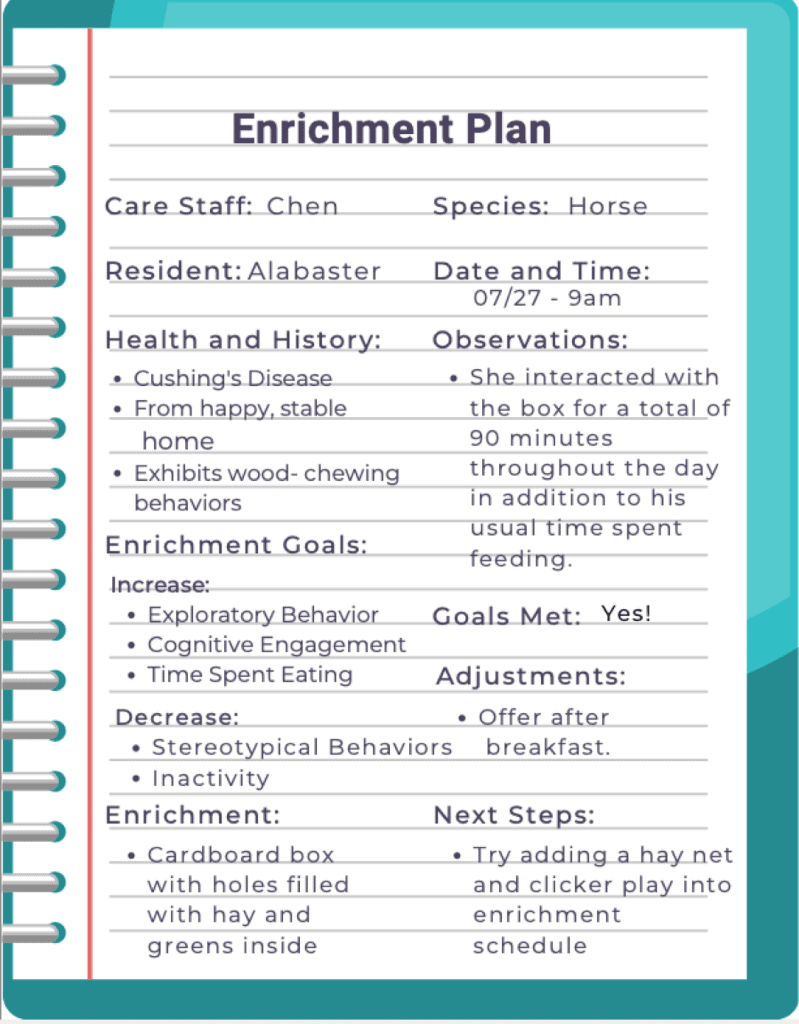
Enrichment can go beyond just offering toys or treats- and that offering enrichment isn’t just a one-time thing! Residents will become bored with certain enrichment that is left in their living space for an extended period, or the same enrichment offered every day (tasty treats being likely an exception to this).
One At A Time!
It is important to only add a single enrichment element at a time when you are first observing and learning whether a resident(s) actually finds it enriching (and for how long they find it enriching before they lose interest). Adding multiple enrichment strategies makes it difficult to get an accurate assessment of the appropriateness of the chosen enrichment. You will be better able to build a schedule when you have more accurate information.
Now that we have covered what an individual enrichment plan looks like, we will cover some of the different types of enrichment for horses and how they could be implemented at your sanctuary.
Observations And Adjustments Are Key!
It’s always important to observe if and how residents use the proffered enrichment. Remember, it is only enrichment if the individual finds it enriching! If they are frightened by something or uninterested in it, then it isn’t enriching.
Social Enrichment
This one may seem obvious, but it’s important to mention! Horses are herd oriented animals, and it’s important they have access to other horses. Of course, there may be times when this isn’t possible, due to medical issues, resident disagreements, or sadly, the death of their companion. In cases like these where direct contact with others of their species isn’t possible, there are ways that you can enrich their lives during this time:
- Provide visual contact with other horses.
- Add a mirror to their living space. (Adding this to a bigger space first is ideal to allow them distance and careful approach.) There are acrylic mirrors that are much safer than glass mirrors.
- Many horses have been known to form strong social bonds with humans. Increasing time spent with an isolated horse may be of benefit during separation from their social group.
- Walk with your horse pal! Using a halter and lead, go on walks with your residents. This is great social time, and time to feel more accustomed to a halter and lead so things can go more smoothly during health checks and transport. Plus it’s great exercise! You can walk with residents (who are safe and comfortable to do so with) in different areas if you have plenty of acreage. Some residents may just walk with you in their outdoor living space without halter and lead.
- Keep a calm buddy nearby and allow physical contact (if contagion isn’t an issue).
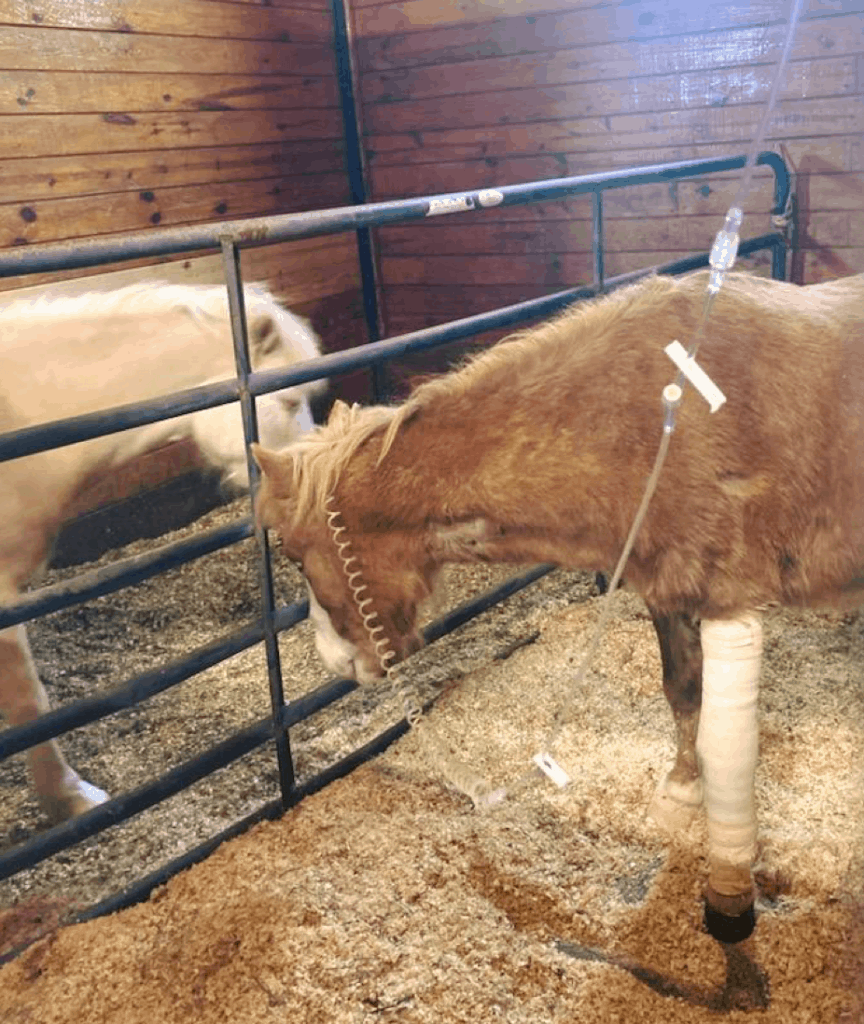
Photo: Unity Farm Sanctuary
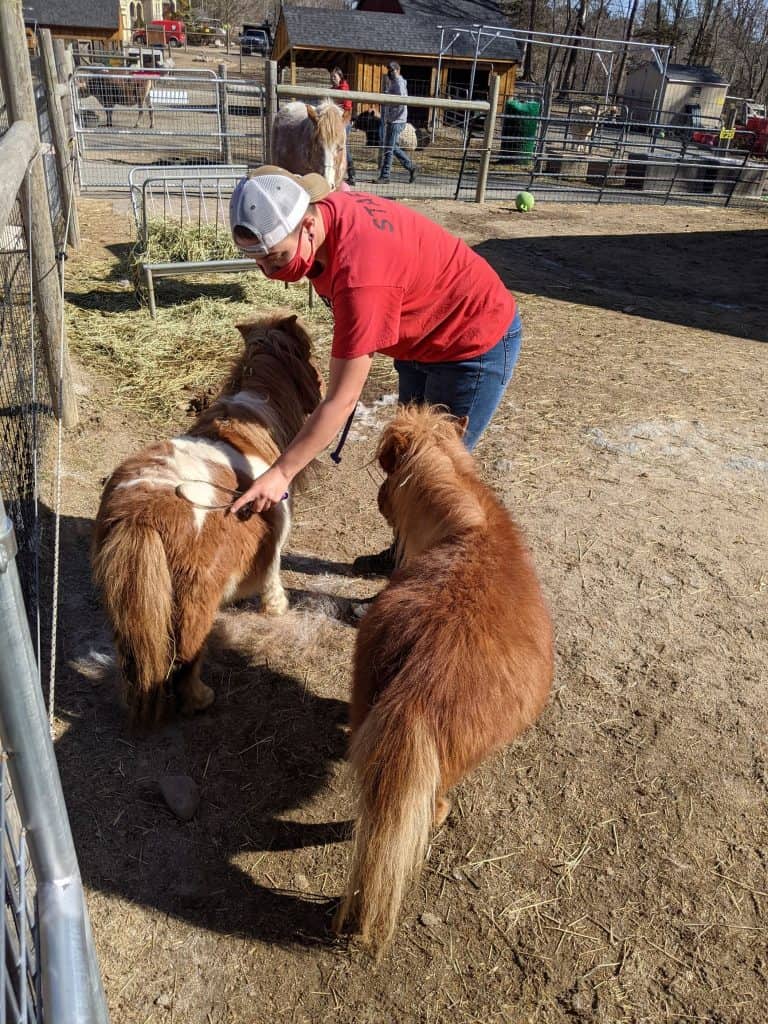
Photo: Unity Farm Sanctuary
Physical Enrichment
Physical or structural enrichment refers to creating a dynamic living space for residents. This is where you should think about what your resident as a species and individual would want in a living space. Check out our Animal-Centered Design resource to learn more about this. Let’s look at some horse-specific physical enrichment:
- Providing multiple water and food “stations”.
- Provide nice dusty or sandy spots for a good roll in the dirt.
- Be careful not to feed residents on sand as they could ingest it, causing an impaction.
- Set up self grooming stations.
- Set up a “trail” using moveable, temporary fencing in a way that encourages them to make use of their outdoor living space to get to certain high value grazing spots. This can also encourage them to run with their companions, so it’s important to ensure spacing is wide enough so no one feels trapped.
- Add new features to their environment on a schedule.
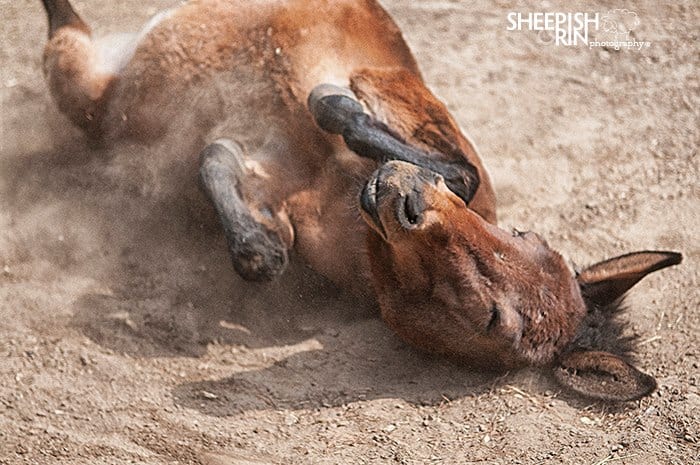
Photo: Sheepish Grin Photography
Nutritional Enrichment
This is a fun one! We all know horses enjoy a good nibble and enjoy an array of tasty treats. Here’s a list of ideas for nutritional enrichment for your horse residents:
- Take a 5 gallon bucket with a secure lid or a plastic barrel and make multiple holes in the sides. It becomes a food dispenser when the residents roll it.
- Add a pile of horse-safe leaves and sprinkle treats throughout.
- Grow safe herbs just outside the fence line so they grow through and residents can snack on them without destroying the whole plant (fingers crossed!)
- Individual horses may exhibit a behavior called contrafreeloading. Contrafreeloading is the term for when an animal will choose to perform a task to receive food even when there is food readily available.
- You may be able to stimulate your horse residents into exhibiting this behavior by packing hay into a cardboard box with holes, feeding balls, or hiding treats in a container like mentioned above. Horses can solve logic puzzles, and this can be used to promote increased feeding behavior that requires some effort on their part- to their enjoyment! Wooden boxes with hinged lids and/or drawers with rope attached can be pulled or lifted by a resident in order to gain access to their treat.
- If you think hiding a resident’s food or making them work for their food is a negative experience for them (everyone is different), you can try an experiment with your residents: Provide a puzzle as described above, or a cardboard box or other container that requires some manipulation in order to get their food, and observe how your residents behave towards each. They will tell you if they find it engaging or not!
- When temperatures are hot, add chopped up produce to a mold, add water, and freeze, creating a cool treat that can keep your residents engaged on a hot day.
- Place fresh herbs, veggies, and fruits throughout a horse’s living space so they can go on a scavenger hunt, encouraging movement and natural behaviors.
- Put horse-safe herbal tea bags (peppermint, ginger, etc.) in a water bucket with warm water and let them steep just enough to add some flavor, but not overwhelmingly so. Remove tea bags and place buckets throughout their living space. These should not replace regular drinking water.
- Bob for produce! Get a little swimming pool or something similar, add chopped up treats, and fill with water.
- Attach two hanging plant baskets together, creating a ball. Make space at the top of one half so you can add treats and forage and hang it securely. (Check carefully for any sharp or loose areas before using.) This is not appropriate for residents with respiratory issues, as dust from hay or other forage can aggravate their condition.
Sensory Enrichment
Sensory enrichment refers to enrichment that engages the senses. Arguably all enrichment engages the senses, but sensory enrichment focuses on sight, touch, hearing, and smell. Each can provide interesting experiences for horse residents!
Sensory Walks
Sensory walks cover all the senses, allowing horses to smell new things, see new scenery, hear different sounds, feel the different textures of surfaces and objects they come into contact with- even tasting something new can be a part of the experience. You don’t have to have tons of acreage in order to guide your resident on this journey. Even simply leaving their enclosure (on halter and lead) and being able to sniff what they want here and there, see a different visual angle of the property, and feel different substrates under their hooves can have an enriching effect. Depending on the health of a resident, you can take them on short walks nearby or long walks further away. You can even set up enrichment focus areas. Of course, this may not be appropriate for every resident. Staff and resident safety must come first, so it isn’t recommended to do this with extremely scared or confrontational residents until they have spent time with caregivers, building a bond and decreasing problematic behavioral responses.
Visual Enrichment
Horses have a behavioral need for scanning the horizon and making sense of their surroundings, and staying connected with their companions. While there hasn’t been much in the way of research studying the effects of visual enrichment in horses, appropriate visual enrichment for horse residents may include:
- Providing access to view the outside and other residents.
- Providing a mirror for residents (if it does not cause them distress). If you know a resident is confrontational with other residents, you might want to skip this. Adding it to their outdoor space first is a good idea if possible, so they can investigate it with the option of moving away.
- Simply adding new items to their living space.
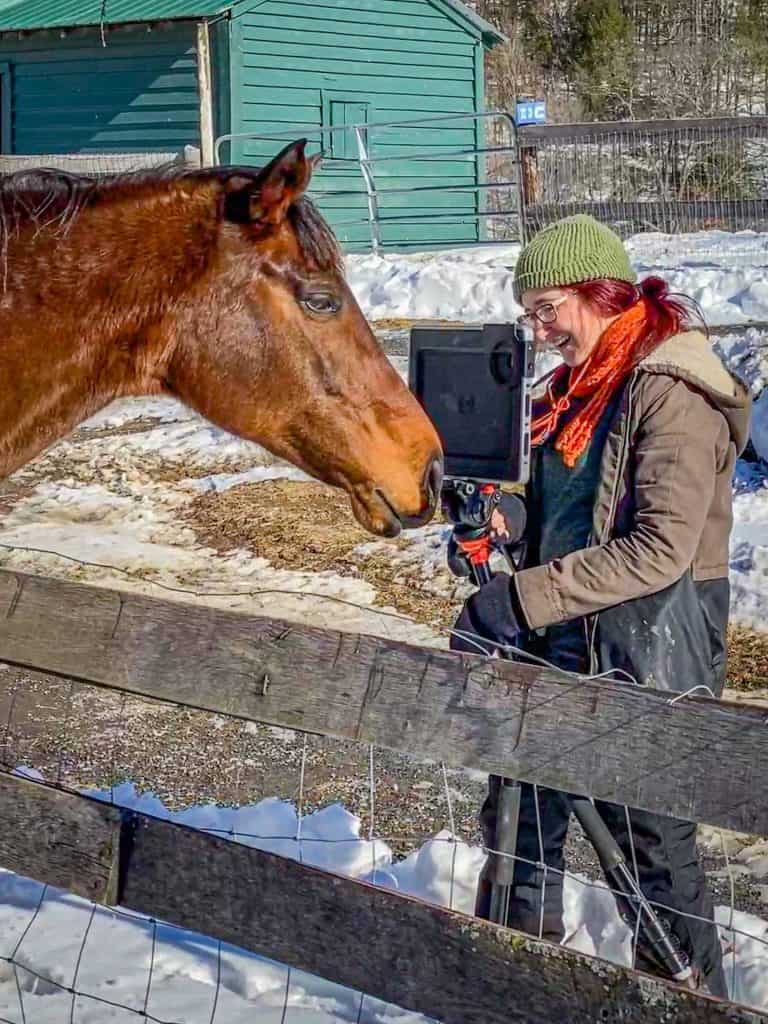
Photo: Catskill Animal Sanctuary
Olfactory Enrichment
Horses use their noses a lot! They use their sense of smell in a number of ways, including identifying what foods to eat, sensing predators, finding young, for mating purposes (obviously not mating at a sanctuary, but as they would in nature), and more. This has implications for horses in sanctuaries. It provides a useful form of enrichment that can be easily provided by care staff. It also means that, because horses have a better sense of smell than humans, staff should consider how strong the scent is they are offering and water it down if possible if it is particularly strong! Strong perfumes or cleaning solutions may also have a negative effect on horse residents.
- If you need to transfer a horse resident to a new living space, add a bit of soiled bedding from their previous space.
- One study revealed that lavender can lower heart rate in horses while being actively inhaled.
- Try adding different fresh herbs around their living space or even horse-safe spices for them to smell.
- Scent two traffic cones or scratching brushes with a spritz of watered down essential oil and one without and see if they investigate the one with the scent more closely. Be sure to never directly apply the essential oils to the resident or provide direct access to essential oils!
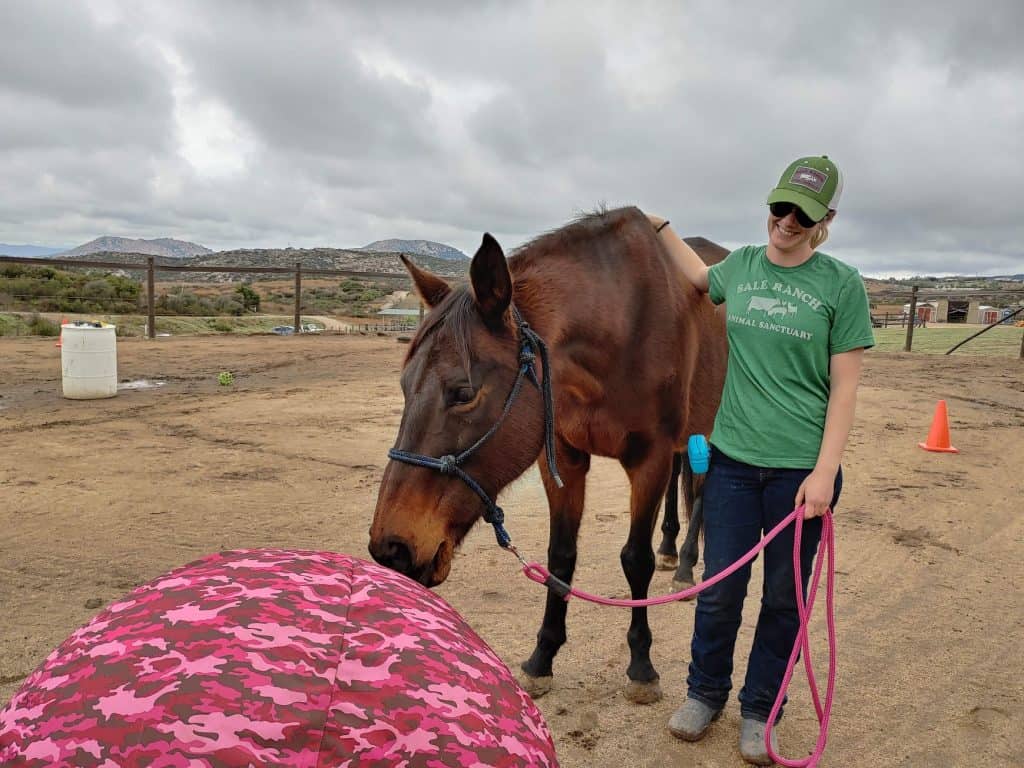
Auditory Enrichment
Do you love a good tune? Or have a favorite song that soothes you? The same can be true for horses! Just remember: Don’t play the music too loudly and avoid chaotic sounds, as horse residents are sensitive! Make sure to observe them to see if this is, in fact, enriching, and doesn’t cause discomfort.
- Horses have been shown to experience reduced stress levels when classical music is played for them.
- Other possibilities include calm rain sounds or soothing music.
- Playing the radio can be problematic as you cannot control the sounds, and sudden loud noises can be upsetting to horse residents.
Tactile Enrichment
To encourage horses to interact with their environment and redirect otherwise problematic behavior, consider adding tactile enrichment to their living spaces. You will start to find that many forms of enrichment overlap! Tactile enrichment strategies might include:
- Attach push broom heads to fencing or other secure areas around both indoor and outdoor living spaces for a good scratch.
- Grooming is a great tactile enrichment and good human-resident bonding time.
- Adding sand or dirt for a nice dust bath can also be stimulating. Avoid putting food on sandy areas, as it can lead to impactions.
- Find objects with different textures and feels, a hanging salt lick, chopped fruit or veggies in water to “bob for apples”, really anything that is safe for them can be added randomly for them to explore. Baskets, traffic cones, cardboard boxes (make sure they don’t eat it), balls with ridges or dulled points like those used in exercise, frozen blocks with treats etc…
- Add things they can manipulate with their hooves, like balls, and things they can toss around with their mouths. Some balls come with a handle just for this purpose!

Photo: Sheepish Grin Photography at Winslow Farm Animal Sanctuary
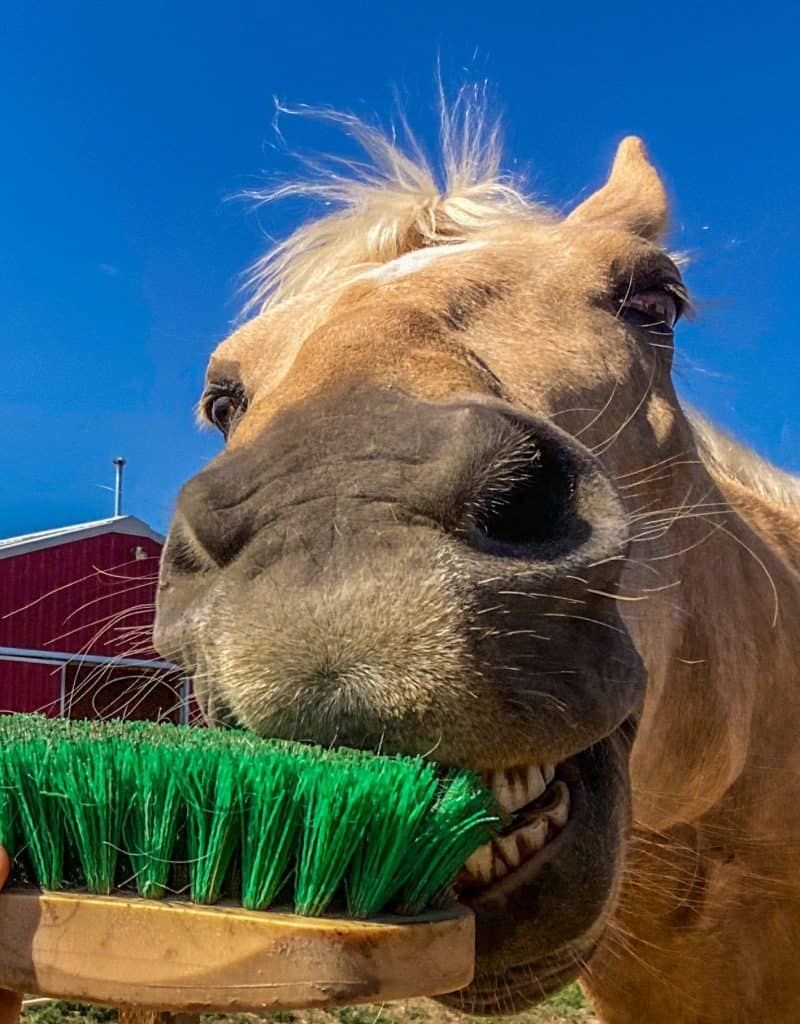
Photo: Luvin’ Arms Animal Sanctuary
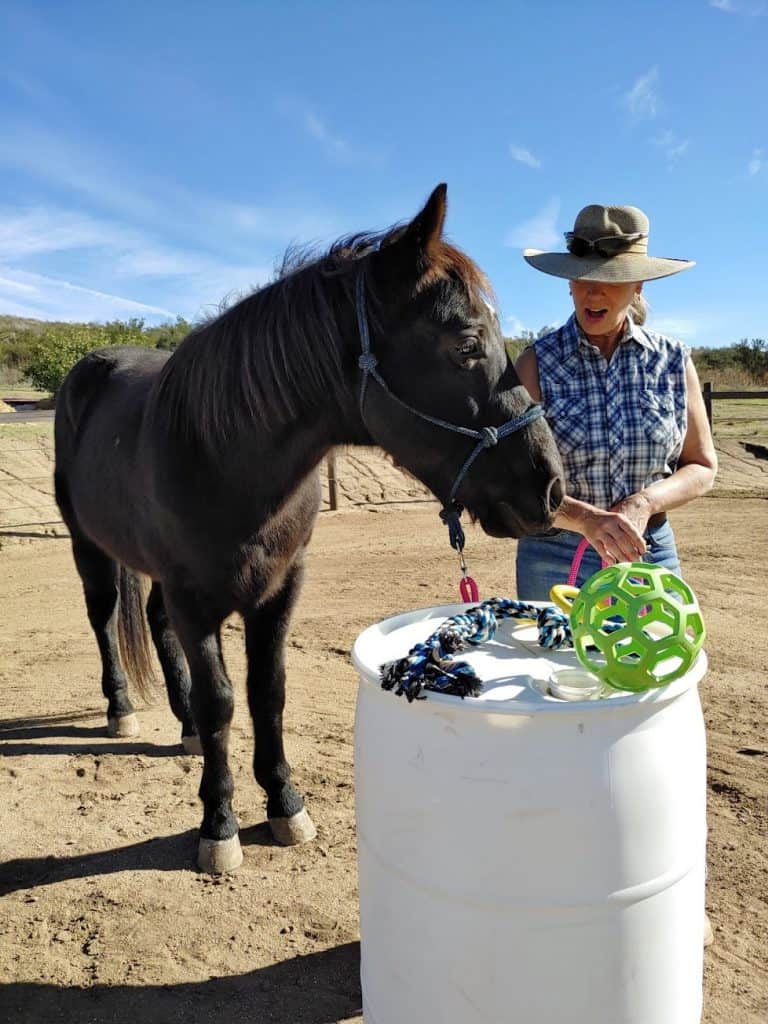
Photo: Sale Ranch Farm Animal Sanctuary
Cognitive Enrichment
Cognitive enrichment involves experiences or environments that encourage curiosity, problem solving behaviors, and learning. A number of enrichment strategies listed above also fall into this category. Puzzle feeders and engaging with curious things in their environment are examples. But lets touch on another form of cognitive enrichment: positive reinforcement learning (This is often referred to as “training”, but we like to refer to it as clicker “learning”, “play” or “bonding”)-
- Positive Reinforcement Engagement
- Many horses may enjoy interacting with their human caregivers. One way to build a strong human-horse bond and boost cognitive functioning in your horse residents is to engage in clicker “learning”. Clicker learning and positive reinforcement are not interchangeable words. However, a clicker can be a useful tool during positive reinforcement engagement!
- Examples of activities to learn with your horse residents could include learning to choose a specific shape or color of an object, rewarding them with an immediate click and treat. Other examples include learning to push a large ball or plastic barrel around or to even play “soccer” with you (exercise and engagement), move through agility courses (you can often make a simple agility course with things you already have on hand or by getting inexpensive supplies), or even to ease fear or reactivity to medical procedures and loading into a trailer. This external link provides a brief tutorial on how to engage horses with a clicker.
Focus On The Resident
It is important to note that clicker learning or play should only be implemented for the positive experiences that can be provided to your residents. This should not be used to encourage behavior that might be unsafe or exploitative.
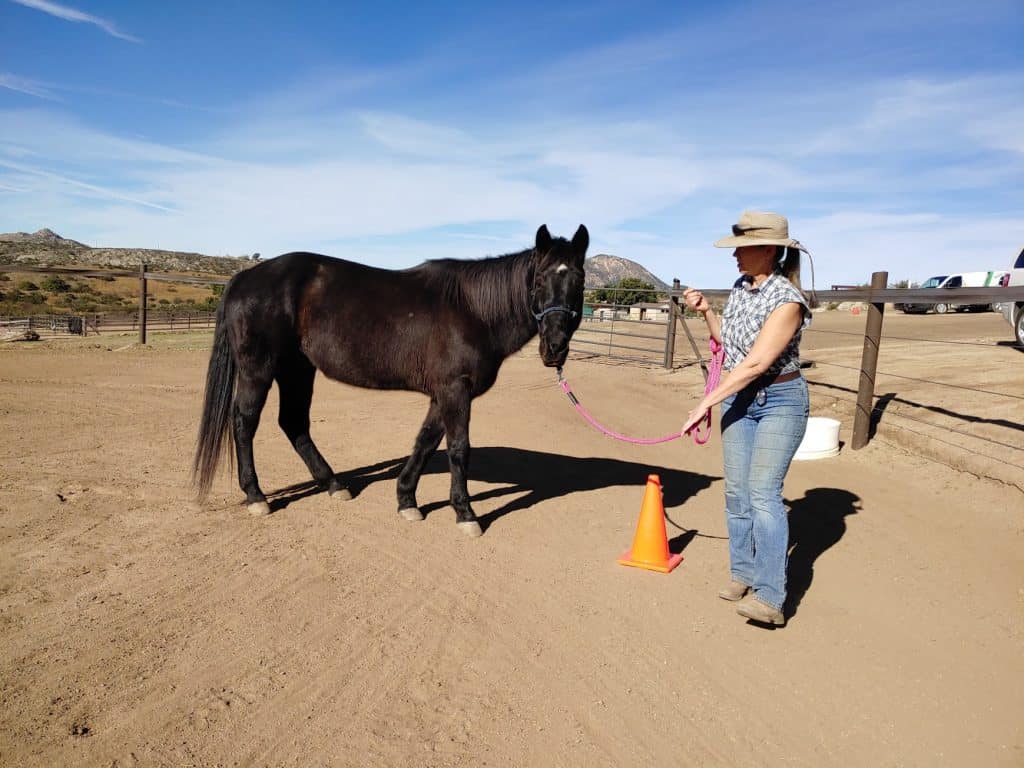
Photo: Sale Ranch Farm Animal Sanctuary
Take Notes
Because every horse is an individual, they are likely to have individual responses to enrichment. When you first add enrichment items, be sure to carefully observe the reactions of your residents. To prevent discomfort to new items or enrichment schedules, consider adding novel objects to an area to the side of their living space that doesn’t require them to walk past the item to go inside, outside, or to reach their water or food. If you believe one of your resident groups or individuals may be fearful of certain enrichment, encouraging them to investigate the object while you are standing by it and encouraging them can help ease fears. This is unlikely to work if you don’t have a bond with the resident. Using food or treats to motivate them to interact with the item is a great way to start. Giving your residents the option to engage or not with enrichment items can be empowering and improve emotional states. Be sure to make notes of any reactions and when their level of interest seems to subside. This will help you know how to best schedule days to change up their enrichment and provide them with a mentally stimulating environment.
Novelty
Novelty can be enriching on its own. However, horses can become unsettled by big sudden changes, so care must be taken to slowly add new things and observe resident reactions. And never make changes to their meal times or change a diet quickly, as this can have serious health complications. Horses are clever and become bored after some time with provided enrichment. For this reason, it is important to incorporate “switch it up” days into your residents’ enrichment schedules!
Building A Schedule
Once you learn more about your residents’ interests, you can build an enrichment schedule to provide varying forms of enrichment as part of your caregiving routine, as well as schedules to replace enrichment. This will keep things interesting for the horses and help provide a stimulating and happy life for your residents.
Do you have an exciting enrichment strategy you use with your horse residents? Tell us all about it!
SOURCES:
Enrichment Tips For Horses | Best Friends
Horse Enrichment Activities | Blue Cross
Lavender Essential Oil Decreases Stress Response Of Horses | Environmental Chemistry Letters (Non-Compassionate Source)
Innovations In Confinement Area Horse-Keeping | The Horse (Non-Compassionate Source)
The Effect Of A Neighbouring Conspecific Versus The Use Of A Mirror For The Control Of Stereotypic Weaving Behaviour In The Stabled Horse | Animal Science (Non-Compassionate Source)
Non-Compassionate Source?
If a source includes the (Non-Compassionate Source) tag, it means that we do not endorse that particular source’s views about animals, even if some of their insights are valuable from a care perspective. See a more detailed explanation here.








